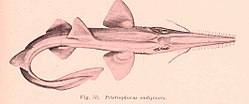| La Meseta Formation | |
|---|---|
| Stratigraphic range: | |
| Type | Geological formation |
| Unit of | Seymour Island Group [1] |
| Underlies | Weddell Formation |
| Overlies | Lopez de Bertodano, Sobral & Cross Valley Formations |
| Thickness | 557 m (1,827 ft) [2] |
| Lithology | |
| Primary | Sandstone, claystone |
| Other | Siltstone, mudstone, conglomerate |
| Location | |
| Coordinates | 64°14′21.782″S56°36′11.69″W / 64.23938389°S 56.6032472°W . [3] |
| Approximate paleocoordinates | 63°42′S61°30′W / 63.7°S 61.5°W |
| Region | Seymour Island |
| Country | Antarctica |
 Geologic map of Seymour Island, Antarctica with La Meseta Formation in dark yellow | |
The La Meseta Formation is a sedimentary sequence deposited during much of the Paleogene on Seymour Island off the coast of the Antarctic Peninsula. It is noted for its fossils, which include both marine organisms and the only terrestrial vertebrate fossils from the Cenozoic of Antarctica. [2] [4]
Contents
- Description
- Paleoenvironment
- Paleobiota
- Mammals
- Birds
- Reptiles
- Amphibians
- Cartilaginous fish
- Ray-finned fish
- Cephalopods
- Plants
- See also
- References
- Further reading
In some treatments, the La Meseta Formation is restricted to just the older Thanetian to Lutetian-aged strata, with the younger Bartonian to Rupelian strata treated as the overlying Submeseta Formation. [5] [6] However, other papers instead treat the Submeseta Formation as an allomember of the La Meseta Formation. [7] [8]







































